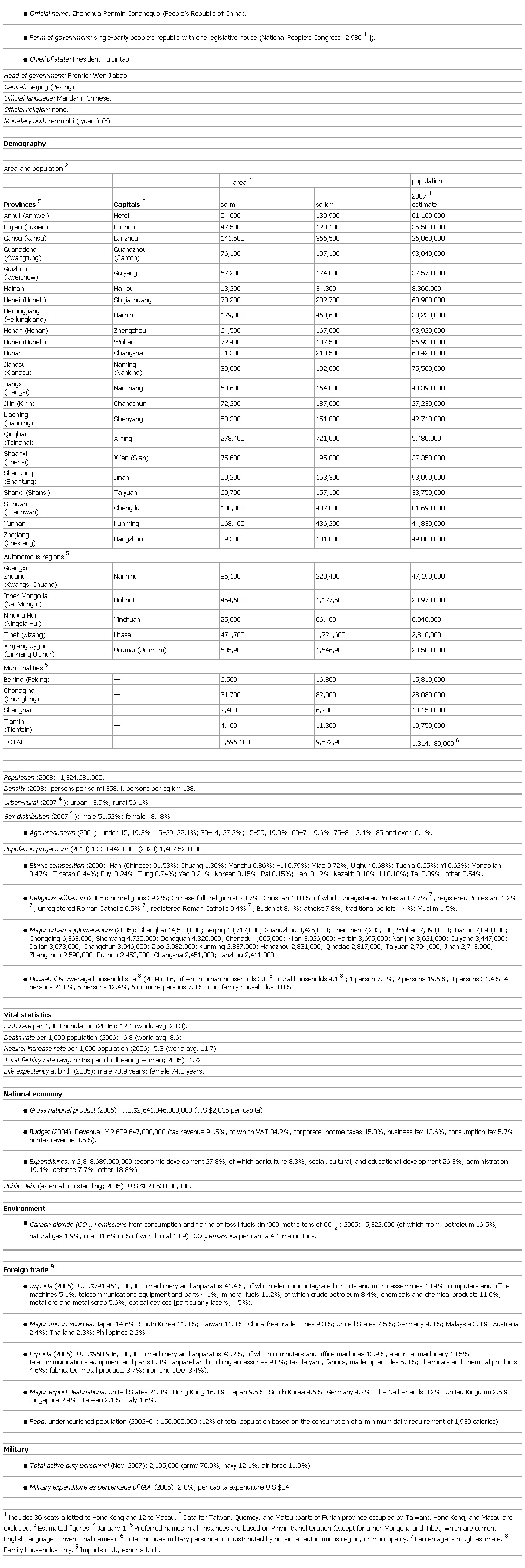- Beijing China olympic wld
-
▪ Table● Official name: Zhonghua Renmin Gongheguo (People’s Republic of China).● Form of government: single-party people’s republic with one legislative house (National People’s Congress [2,9801]).● Chief of state: President Hu Jintao.Head of government: Premier Wen Jiabao.Official language: Mandarin Chinese.Official religion: none.Monetary unit: renminbi ( yuan) (Y).Area and population2area3 populationProvinces5 Capitals5 sq mi sq km 20074estimateAnhui (Anhwei) Hefei 54,000 139,900 61,100,000Fujian (Fukien) Fuzhou 47,500 123,100 35,580,000Gansu (Kansu) Lanzhou 141,500 366,500 26,060,000Guangdong(Kwangtung) Guangzhou(Canton) 76,100 197,100 93,040,000Guizhou(Kweichow) Guiyang 67,200 174,000 37,570,000Hainan Haikou 13,200 34,300 8,360,000Hebei (Hopeh) Shijiazhuang 78,200 202,700 68,980,000Heilongjiang(Heilungkiang) Harbin 179,000 463,600 38,230,000Henan (Honan) Zhengzhou 64,500 167,000 93,920,000Hubei (Hupeh) Wuhan 72,400 187,500 56,930,000Hunan Changsha 81,300 210,500 63,420,000Jiangsu(Kiangsu) Nanjing(Nanking) 39,600 102,600 75,500,000Jiangxi(Kiangsi) Nanchang 63,600 164,800 43,390,000Jilin (Kirin) Changchun 72,200 187,000 27,230,000Liaoning(Liaoning) Shenyang 58,300 151,000 42,710,000Qinghai(Tsinghai) Xining 278,400 721,000 5,480,000ShaanxiShandong(Shantung) Jinan 59,200 153,300 93,090,000Shanxi (Shansi) Taiyuan 60,700 157,100 33,750,000Sichuan(Szechwan) Chengdu 188,000 487,000 81,690,000Yunnan Kunming 168,400 436,200 44,830,000Zhejiang(Chekiang) Hangzhou 39,300 101,800 49,800,000Autonomous regions5GuangxiZhuang(Kwangsi Chuang) Nanning 85,100 220,400 47,190,000Inner Mongolia(Nei Mongol) Hohhot 454,600 1,177,500 23,970,000Ningxia Hui(Ningsia Hui) Yinchuan 25,600 66,400 6,040,000Tibet (Xizang) Lhasa 471,700 1,221,600 2,810,000Xinjiang Uygur(Sinkiang Uighur) Ürümqi (Urumchi) 635,900 1,646,900 20,500,000Municipalities5Beijing (Peking) — 6,500 16,800 15,810,000Chongqing(Chungking) — 31,700 82,000 28,080,000Shanghai — 2,400 6,200 18,150,000Tianjin(Tientsin) — 4,400 11,300 10,750,000TOTAL 3,696,100 9,572,900 1,314,480,0006Population (2008): 1,324,681,000.Density (2008): persons per sq mi 358.4, persons per sq km 138.4.Urban-rural (20074): urban 43.9%; rural 56.1%.Sex distribution (20074): male 51.52%; female 48.48%.● Age breakdown (2004): under 15, 19.3%; 15–29, 22.1%; 30–44, 27.2%; 45–59, 19.0%; 60–74, 9.6%; 75–84, 2.4%; 85 and over, 0.4%.Population projection: (2010) 1,338,442,000; (2020) 1,407,520,000.● Ethnic composition (2000): Han (Chinese) 91.53%; Chuang 1.30%; Manchu 0.86%; Hui 0.79%; Miao 0.72%; Uighur 0.68%; Tuchia 0.65%; Yi 0.62%; Mongolian 0.47%; Tibetan 0.44%; Puyi 0.24%; Tung 0.24%; Yao 0.21%; Korean 0.15%; Pai 0.15%; Hani 0.12%; Kazakh 0.10%; Li 0.10%; Tai 0.09%; other 0.54%.● Religious affiliation (2005): nonreligious 39.2%; Chinese folk-religionist 28.7%; Christian 10.0%, of which unregistered Protestant 7.7%7, registered Protestant 1.2%7, unregistered Roman Catholic 0.5%7, registered Roman Catholic 0.4%7; Buddhist 8.4%; atheist 7.8%; traditional beliefs 4.4%; Muslim 1.5%.● Major urban agglomerations (2005): Shanghai 14,503,000; Beijing 10,717,000; Guangzhou 8,425,000; Shenzhen 7,233,000; Wuhan 7,093,000; Tianjin 7,040,000; Chongqing 6,363,000; Shenyang 4,720,000; Dongguan 4,320,000; Chengdu 4,065,000; Xi'an 3,926,000; Harbin 3,695,000; Nanjing 3,621,000; Guiyang 3,447,000; Dalian 3,073,000; Changchun 3,046,000; Zibo 2,982,000; Kunming 2,837,000; Hangzhou 2,831,000; Qingdao 2,817,000; Taiyuan 2,794,000; Jinan 2,743,000; Zhengzhou 2,590,000; Fuzhou 2,453,000; Changsha 2,451,000; Lanzhou 2,411,000.● Households. Average household size8 (2004) 3.6, of which urban households 3.08, rural households 4.18; 1 person 7.8%, 2 persons 19.6%, 3 persons 31.4%, 4 persons 21.8%, 5 persons 12.4%, 6 or more persons 7.0%; non-family households 0.8%.Birth rate per 1,000 population (2006): 12.1 (world avg. 20.3).Death rate per 1,000 population (2006): 6.8 (world avg. 8.6).Natural increase rate per 1,000 population (2006): 5.3 (world avg. 11.7).Total fertility rate (avg. births per childbearing woman; 2005): 1.72.Life expectancy at birth (2005): male 70.9 years; female 74.3 years.National economy● Gross national product (2006): U.S.$2,641,846,000,000 (U.S.$2,035 per capita).● Budget (2004). Revenue: Y 2,639,647,000,000 (tax revenue 91.5%, of which VAT 34.2%, corporate income taxes 15.0%, business tax 13.6%, consumption tax 5.7%; nontax revenue 8.5%).● Expenditures: Y 2,848,689,000,000 (economic development 27.8%, of which agriculture 8.3%; social, cultural, and educational development 26.3%; administration 19.4%; defense 7.7%; other 18.8%).● Carbon dioxide (CO2) emissions from consumption and flaring of fossil fuels (in ’000 metric tons of CO2; 2005): 5,322,690 (of which from: petroleum 16.5%, natural gas 1.9%, coal 81.6%) (% of world total 18.9); CO2 emissions per capita 4.1 metric tons.Foreign trade9● Imports (2006): U.S.$791,461,000,000 (machinery and apparatus 41.4%, of which electronic integrated circuits and micro-assemblies 13.4%, computers and office machines 5.1%, telecommunications equipment and parts 4.1%; mineral fuels 11.2%, of which crude petroleum 8.4%; chemicals and chemical products 11.0%; metal ore and metal scrap 5.6%; optical devices [particularly lasers] 4.5%).● Major import sources: Japan 14.6%; South Korea 11.3%; Taiwan 11.0%; China free trade zones 9.3%; United States 7.5%; Germany 4.8%; Malaysia 3.0%; Australia 2.4%; Thailand 2.3%; Philippines 2.2%.● Exports (2006): U.S.$968,936,000,000 (machinery and apparatus 43.2%, of which computers and office machines 13.9%, electrical machinery 10.5%, telecommunications equipment and parts 8.8%; apparel and clothing accessories 9.8%; textile yarn, fabrics, made-up articles 5.0%; chemicals and chemical products 4.6%; fabricated metal products 3.7%; iron and steel 3.4%).● Major export destinations: United States 21.0%; Hong Kong 16.0%; Japan 9.5%; South Korea 4.6%; Germany 4.2%; The Netherlands 3.2%; United Kingdom 2.5%; Singapore 2.4%; Taiwan 2.1%; Italy 1.6%.● Food: undernourished population (2002–04) 150,000,000 (12% of total population based on the consumption of a minimum daily requirement of 1,930 calories).● Total active duty personnel (Nov. 2007): 2,105,000 (army 76.0%, navy 12.1%, air force 11.9%).● Military expenditure as percentage of GDP (2005): 2.0%; per capita expenditure U.S.$34.1Includes 36 seats allotted to Hong Kong and 12 to Macau. 2Data for Taiwan, Quemoy, and Matsu (parts of Fujian province occupied by Taiwan), Hong Kong, and Macau are excluded. 3Estimated figures. 4January 1. 5Preferred names in all instances are based on Pinyin transliteration (except for Inner Mongolia and Tibet, which are current English-language conventional names). 6Total includes military personnel not distributed by province, autonomous region, or municipality. 7Percentage is rough estimate. 8Family households only. 9Imports c.i.f., exports f.o.b.See as table:

* * *
Universalium. 2010.
